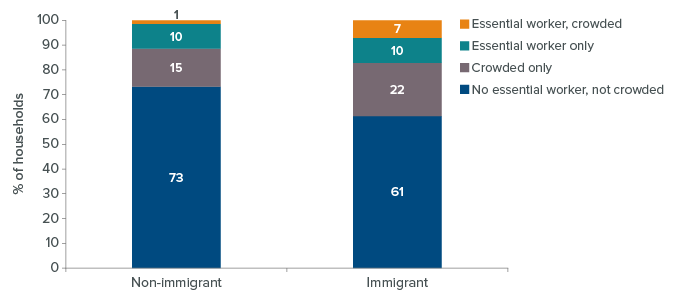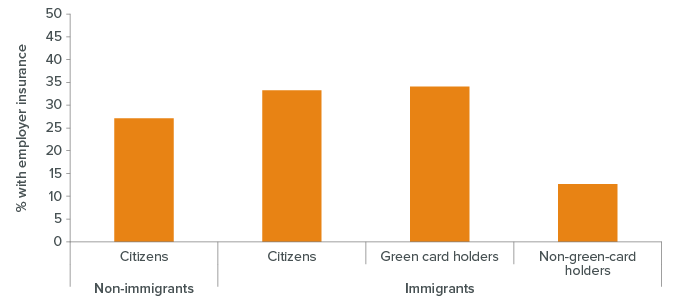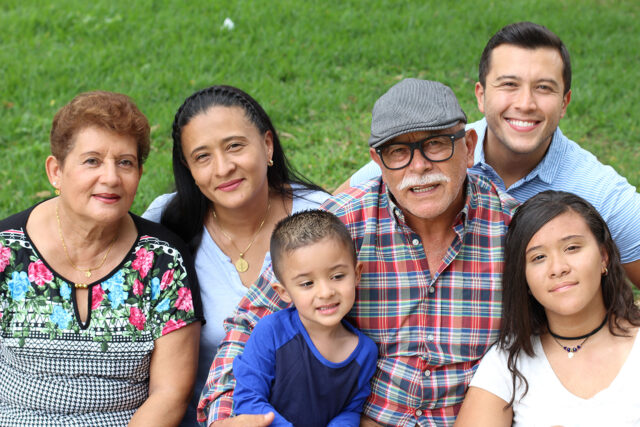- Work is a source of health risk for many immigrants . . .
Immigrants generally tend to be healthier than US-born individuals, reflecting the fact that many came to the US to work; this is called the “healthy immigrant effect” or the “Latino paradox,” in the case of Latinos. However, immigrants are disproportionately represented in occupations such as construction and agricultural work that have high rates of workplace injury and exposure to unhealthy heat, pesticides, or other chemicals. In some sectors, immigrants are 15% to 25% more likely to be fatally injured at work compared to US-born workers. - . . . and low-income immigrants are especially vulnerable to COVID-19.
During the COVID-19 pandemic, essential jobs—which cannot be performed remotely—have been sources of coronavirus risk for many immigrant workers and their families. In California, cooks and agricultural workers have had among the highest excess mortality rates during the pandemic. In addition, low-income immigrants often live in households that are crowded and/or multi-generational. These and other factors have led to disproportionate deaths among immigrants in California; working-aged Latino immigrants are 8 to 11 times more likely to have died of coronavirus compared to US-born non-Latinos. Universal access to virus testing, treatment, and vaccination will be essential to overcoming the pandemic in California.
Immigrant households are more likely to have an essential worker, be crowded, or both

SOURCE: American Community Survey 2019 public-use microdata, accessed through IPUMS.
NOTES: Differences across counties are due to variation in both eligibility and take-up of the EITC. Eligibility hinges on adjusted gross income, and filers must have social security numbers and limited investment income. Most recipients have one or more dependent children.
- Immigrants and their families are less likely to have health insurance.
Only about 8% of Californians have no form of health insurance, but a disproportionate share are immigrants; they make up 27% of the state but 48% of the uninsured. Fewer than 4% of children are uninsured; some of these children may be in families with limited coverage options due to barriers like immigration status. Almost two-thirds of uninsured individuals (65% of adults and 63% of children) live with at least one family member who is an immigrant. Low-income immigrants without green cards—many of whom are undocumented—are less likely to have public health insurance or access to employer insurance compared to immigrants with US citizenship or green cards.
Low-income immigrants without green cards have limited access to employer insurance

SOURCE: California Health Interview Survey 2019 adult file.
NOTES: Includes all California households. Immigrant households have at least one foreign-born member. A household is crowded if it has more than one person per room. A household has an essential worker if at least one member works in an occupation described as essential in California’s March 2020 stay-at-home order. Percentages may not sum to 100 due to rounding.
- Undocumented immigrants have fewer coverage options.
California recently expanded Medi-Cal (the state’s Medicaid program) to cover all low-income children and young adults, regardless of immigration status, but most undocumented immigrants are older and therefore ineligible. A limited version of Medi-Cal covers emergencies and specific types of care, but it is not comprehensive coverage. Undocumented immigrants are unable to buy plans through Covered California, the state’s marketplace, and they are less likely to have insurance through employers. All Californians can purchase a plan directly from an insurer, but this can be unaffordable. In March 2021, 66% of California adults supported health care coverage for undocumented immigrants, up from 54% in 2015. - Lack of data leaves many unanswered questions about immigrant health.
California has made large investments to expand insurance coverage among immigrants, but little is known about whether access to care has improved. About 60% of noncitizen immigrants in California had a routine checkup in the past year, compared to over 70% of US-born and naturalized citizens. Moreover, low-income uninsured immigrants’ tendency to pay cash or receive charity care means that their health care interactions will not appear in most data sources—not even the coming California Healthcare Payments Database. The dearth of information poses a challenge for policymakers who want to reduce barriers to accessing care. - Federal immigration reform could bring many into the health care mainstream.
The Biden administration has signaled an interest in giving undocumented immigrants opportunities to apply for temporary legal status and eventually US citizenship. These changes could make undocumented immigrants eligible for Medi-Cal or Covered California premium subsidies if they meet income limits. Coverage and legal immigration status could together open the door for immigrants and their family members to receive regular, comprehensive health care.



